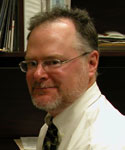|
When faculty and staff in the College of Arts and Sciences want to communicate globally, they turn to cameras, microphones, and television sets— and, increasingly, to laptops and highspeed Internet— for videoconferencing.
A common communications tool in corporate America, videoconferencing is new to Arts and Sciences. But it has begun to permeate the College in a number of applications, including faculty searches, research collaborations, guest lectures, and artistic performances around the world.
 |
| Tom Knab |
The potential of videoconferencing became clear to Dean Mark Turner and Chief Information Officer Thomas Knab when a faculty committee consulted experts in Canada, Denmark, Belgium, and the United States last year about designing the College's new department of cognitive science.
The success of that collaboration led Turner to encourage 16 departments conducting faculty searches this year to use the technology for initial interviews as a means of "casting the widest net possible." On a single day in January, for example, Knab and Case MediaVision arranged for the department of music to interview seven applicants in five different time zones, from Rome to London to California.
Not only does this approach expand the pool of first-round candidates; it also saves the College money and effort in the initial search phase.
Face-to-face interaction is the ideal form of communication when meeting someone new, noted Todd Oakley, associate professor of English and cognitive science. "But," he added, "once you get used to the technology, it is almost like having the candidate or expert in the room."
Oakley has had many opportunities to observe the benefits of videoconferencing: as a member of search committees and of the exploratory committee for cognitive science; as an external adviser for a doctoral student at the University of Aarhaus in Denmark; and as a collaborator on special journal projects. In each case, Oakley has found that videoconferences are superior to e-mails or phone calls.
"You know what the other person means," Oakley said, "because you have the tone of voice and the gestures that make communication so precise."
 |
| Kinetic Shadows |
Even before he joined the College last year, Tom Knab was introducing the Case community to innovative uses of videoconferencing technology. In October 2002, while he was director of distancelearning networking at the Cleveland Institute of Music, Knab provided the technical expertise to create "Kinetic Shadows," a dance performance choreographed by Case assistant professor of dance Gary Galbraith. For this event, dancers and musicians in Cleveland and Los Angeles collaborated in a seamless, interactive performance broadcast over the high-speed Internet2 network.
More recently, Knab connected Arthur Heuer, a ceramics expert from the Case School of Engineering, conservators at the Cleveland Museum of Art, and researchers at the Louvre Museum in Paris to determine the authenticity of ceramic works attributed to the 16th-century French artist Bernard Palissy. The Case music department and MediaVision have also partnered with Indiana University to conduct the first live stereoscopic 3-D videoconference.
In working with different networking sites, Knab has expanded the College's global connections. For example, the music department's interview with a candidate at London's Royal Academy of Music has sparked discussions about joint classes involving the two institutions.
According to Knab, exposure to videoconferencing has also led many faculty members to experiment with classroom applications.
Last fall, when physics professor Philip Taylor taught "Quantum Theory of Solids," he linked sixteen graduate students from Case and Syracuse University, using internet protocol (IP) videoconferencing. Taylor also used Smart Board technology, which enabled him to transmit the equations and notes for his lectures to the receiving classroom at Syracuse.
"We'll continue to partner with the MediaVision initiatives at Case to expand the use of this technology across the university," said Knab. "We'd like to see IP videoconferencing used to communicate with prospective students, alumni, and others in the dynamic Case community. Soon, you'll even be able to connect by videoconference to the new SAGES café on the first floor of Crawford Hall.
"We feel the College is leading the charge in this area and initiating a cultural change in how the university thinks about global communications."
|